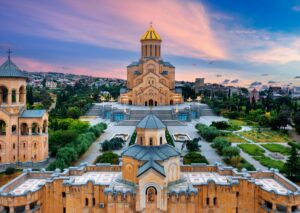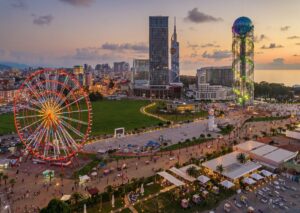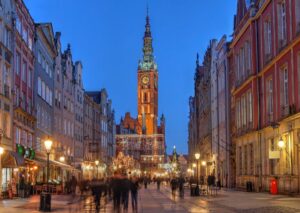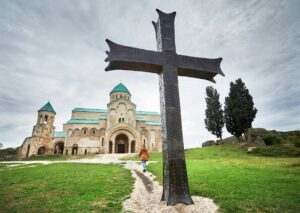The gravel crunches softly beneath my feet as I walk through the gates of Auschwitz-Birkenau. The air feels heavy, not just with the weight of history, but with the millions of stories that ended here – stories of lives cut short, of families torn apart, of unimaginable suffering. As I stand before the infamous “Arbeit Macht Frei” sign, a chill runs down my spine that has nothing to do with the cool Polish breeze. This is Auschwitz-Birkenau, a place that stands as a stark reminder of the darkest chapter in human history, a testament to the depths of cruelty we can sink to, and a powerful call to ensure such atrocities never happen again.

Hello, fellow travelers and seekers of understanding. In this post, we’re embarking on a journey that’s unlike any other I’ve shared before. This isn’t a typical travel destination, and this won’t be a typical travel blog. Instead, we’re going to explore how to approach a visit to Auschwitz-Birkenau with the respect, solemnity, and open heart it demands. This guide aims to prepare you not just logistically, but emotionally and mentally for an experience that will likely stay with you for the rest of your life.
Understanding Auschwitz-Birkenau: A Deep Dive into History
Before we delve into the practicalities of visiting, it’s crucial to understand what Auschwitz-Birkenau represents:

- Auschwitz-Birkenau was the largest Nazi concentration and death camp, operational from 1940 to 1945.
- Over 1.1 million people were murdered here, the vast majority of whom were Jews.
- The complex consists of three main parts: Auschwitz I (the main camp), Auschwitz II-Birkenau (a combined concentration/extermination camp), and Auschwitz III-Monowitz (a labor camp).
- Today, it stands as a museum and memorial, dedicated to preserving the memory of those who perished and educating visitors about the Holocaust.
The Historical Context
To truly comprehend the significance of Auschwitz-Birkenau, it’s essential to understand its place in the broader context of World War II and the Holocaust:
- The camp was established in 1940, initially to hold Polish political prisoners.
- As part of the Nazi’s “Final Solution,” it became a center for the mass extermination of Jews from all over Europe.
- Prisoners were subjected to forced labor, medical experiments, and systematic murder.
- The liberation of Auschwitz by Soviet troops on January 27, 1945, revealed the full extent of the atrocities to the world.
Emotional Insight: As you prepare for your visit, try to remember that each statistic represents individual human beings – mothers, fathers, children, friends – each with their own hopes, dreams, and stories.
Location and Context
Auschwitz-Birkenau is located near the town of Oświęcim in southern Poland, about 70 kilometers west of Krakow. The site is now officially known as the Auschwitz-Birkenau Memorial and Museum.
- Language: Polish (English is widely spoken at the museum)
- Currency: Polish Złoty (PLN)
- Time Zone: Central European Time (CET)
The Town of Oświęcim
It’s important to note that Oświęcim is a living town with its own history that predates and continues beyond the Holocaust. While visiting, remember that this is home to thousands of people who live with the weight of this history every day.
Cultural Tip: If you have time, consider exploring Oświęcim itself. The Auschwitz Jewish Center offers insights into the town’s Jewish history before the war.
How to Get There
By Air
The nearest major airport is Krakow John Paul II International Airport (KRK). From here, you have several options to reach Auschwitz-Birkenau:
- Organized Tour: Many companies offer day trips from Krakow, which include transportation. This can be booked through GetYourGuide.com.
- Public Bus: Regular buses run from Krakow Main Bus Station (Kraków MDA) to Oświęcim. The journey takes about 1.5-2 hours.
- Train: Trains run from Krakow Główny station to Oświęcim station. The journey takes about 1.5-2 hours.
- Private Transfer: For a more flexible option, you can book a private transfer through services like DiscoverCars.com.
Travel Tip: If you’re prone to motion sickness, consider taking medication before the journey. The roads can be winding, and you’ll want to arrive feeling as comfortable as possible.
By Car
If you prefer to drive, you can rent a car from Krakow or other major Polish cities. The drive from Krakow takes about 1-1.5 hours. Remember to book your parking spot in advance through the museum’s official website.
Driving Insight: The drive to Auschwitz can be a time for quiet reflection. Consider listening to an audiobook about Holocaust history to prepare yourself mentally for the visit.
How to Get Around
Once you’re in Oświęcim, getting to and around the Auschwitz-Birkenau complex is relatively straightforward:
- Shuttle Bus: A free shuttle bus runs between Auschwitz I and Auschwitz II-Birkenau every 10 minutes during opening hours.
- Walking: It’s possible to walk between the two sites, but it’s about 3 kilometers and takes around 30-40 minutes.
- Local Bus: Local buses in Oświęcim can take you to both sites.
- Taxi: Taxis are available, but ensure you agree on the fare before starting your journey.
Accessibility Note: If you have mobility issues, inform the museum in advance. They can provide assistance and even transport between sites if necessary.
Where to Stay
While many visitors choose to base themselves in Krakow and visit Auschwitz-Birkenau as a day trip, staying in Oświęcim allows for a more in-depth visit. Here are some options:
Budget:


- Mirror Apartments: Basic but comfortable accommodation close to the memorial.
Mid-range:



- Hampton by Hilton Oswiecim: A well-reviewed hotel about 500 meters from the memorial.



- Hotel Imperiale: Located in the center of Oświęcim, offering comfortable rooms.
Luxury:
- While there aren’t luxury hotels in Oświęcim itself, you can find high-end options in nearby Krakow.
Remember to book your accommodation through Booking.com for the best rates and flexibility.
Emotional Consideration: Staying in Oświęcim can be a profound experience, allowing you to reflect on your visit in the evening and return the next day if you wish. However, some visitors prefer to return to the relative normality of Krakow after such an emotionally challenging day.
Visiting Auschwitz-Birkenau: What to Expect
Entry and Tours


- Entry to Auschwitz-Birkenau is free, but you must reserve a specific entry time in advance through the official website.
- Guided tours are highly recommended for a deeper understanding of the site’s history.
- Tours are available in various languages and typically last about 3.5 hours.
Insider Tip: Book your entry time or tour as far in advance as possible, especially during peak season (April to October).
Key Areas to Visit
- Auschwitz I:
- Block 4: Evidence of Crimes

This block houses exhibits showing evidence of Nazi atrocities, including personal belongings confiscated from victims like shoes, clothing, eyeglasses, and suitcases. It provides a visceral understanding of the scale of human suffering.
- Block 5: Material Evidence of Crimes


Similar to Block 4, this area displays thousands of personal items taken from prisoners, further illustrating the magnitude of lives affected.
- Block 11: The Death Block

Known as the camp prison, this block was used for punishments, torture, and executions. It contains standard cells, dark cells, and standing cells. The basement, called “the bunker,” was used for solitary confinement and extreme torture.
- Gas Chamber and Crematorium I

This was the first gas chamber and crematorium at Auschwitz, disguised as a shower room. Thousands were murdered here using Zyklon B gas. Though partially reconstructed, it provides a chilling insight into the mechanics of mass murder.
2. Auschwitz II-Birkenau:
- The Gate of Death

The iconic entrance to Birkenau, where trains carrying deportees entered the camp.
- The Unloading Ramp

This is where selections took place upon arrival, determining who would be sent directly to the gas chambers and who would be used for forced labor.
- The Ruins of Gas Chambers and Crematoria II and III

These were the largest killing facilities at Birkenau. Though in ruins (destroyed by the Nazis in an attempt to hide evidence), they are powerful reminders of the scale of the genocide.
- The Sauna – Central Camp Bathhouse

This building was used for prisoner registration and disinfection. Today it houses a permanent exhibition with photographs and documents about prisoners’ lives.
Emotional Preparation: Each of these areas carries immense emotional weight. Take your time, and don’t hesitate to step away if you need a moment to collect yourself.
Emotional Preparation and Self-Care
Visiting Auschwitz-Birkenau is an emotionally challenging experience. Here are some expanded tips to help you prepare and cope:
- Before Your Visit:
- Educate yourself about the Holocaust and Auschwitz’s history.
- Reflect on your reasons for visiting and what you hope to gain from the experience.
- Consider your emotional limits and plan accordingly.
- During Your Visit:
- Don’t rush through the exhibits. Allow yourself time to process what you’re seeing.
- It’s okay to feel overwhelmed. Take breaks if you need to.
- Stay hydrated and eat something, even if you don’t feel hungry.
- If you’re visiting with others, check in with each other regularly.
- After Your Visit:
- Allow time for reflection. Don’t plan any major activities for the rest of the day.
- Consider journaling or discussing your experience with others to help process your thoughts and feelings.
- Be kind to yourself. It’s normal to feel a range of emotions, including sadness, anger, or numbness.
- If you’re struggling to cope, don’t hesitate to seek professional support.
Self-Care Tip: Bring a small comfort item with you – a photo of loved ones, a meaningful piece of jewelry, or even a smooth stone to hold. This can serve as an anchor when emotions become overwhelming.
Best Time to Visit
Auschwitz-Birkenau is open year-round, except for January 1, December 25, and Easter Sunday. Each season offers a different experience:

- Summer (June-August): Busiest season with the largest crowds. The weather is generally pleasant, but can be hot.
Tip: Visit early in the morning or late afternoon to avoid the worst of the crowds and heat. - Spring/Fall (April-May, September-October): Milder weather and fewer crowds. A good balance for most visitors.
Insight: The changing seasons can provide a poignant backdrop to your visit, highlighting the passage of time and the endurance of memory. - Winter (November-March): Least crowded, but the weather can be harsh. Visiting in winter can provide a stark, powerful atmosphere that aligns with the site’s somber nature.
Emotional Impact: The cold and darkness of winter can give you a small sense of the conditions prisoners endured, adding another layer to your understanding.
Weather Consideration: Regardless of when you visit, check the forecast and dress appropriately. Much of your visit will be outdoors, and being physically uncomfortable can detract from your ability to engage with the site fully.
Packing Tips
When visiting Auschwitz-Birkenau, it’s important to pack respectfully and practically:
- Comfortable, sturdy walking shoes (you’ll be on your feet for several hours)
- Modest, respectful clothing (avoid shorts, sleeveless shirts, etc.)
- Layers for unpredictable weather
- Umbrella or rain jacket
- Water bottle (stay hydrated, especially in summer)
- Small backpack for essentials
- Camera (photography is allowed in most areas, but be respectful)
- Notebook and pen for reflection
- Tissues or handkerchief
- Portable charger for your phone
Thoughtful Addition: Consider bringing a small stone to leave at the memorial, which is a Jewish tradition for honoring the deceased.
Is It Safe?
Visiting Auschwitz-Birkenau is generally safe, but as with any travel, it’s important to be aware of your surroundings:
- The memorial is well-maintained and staffed.
- Follow all rules and guidelines set by the museum.
- Be respectful of other visitors and their emotional experiences.
- Keep your belongings close, especially in crowded areas.
Emergency number in Poland: 112
Safety Tip: If you’re feeling overwhelmed or unwell during your visit, don’t hesitate to approach a staff member for assistance.
Budget-Friendly Tips
While entry to Auschwitz-Birkenau is free, associated costs can add up. Here are some tips to keep your visit budget-friendly:
- Book your entry time well in advance to avoid paying for a guided tour if you prefer to explore independently.
- Use public transportation instead of private transfers.
- Pack a lunch to avoid expensive on-site options.
- Consider staying in Krakow and taking a day trip, as accommodation can be cheaper.
- Look for combo tickets if you’re planning to visit other sites in the area.
Money-Saving Hack: If you’re a student, teacher, or senior, bring an appropriate ID for potential discounts on tours and transportation.
How Long to Stay
The length of your visit depends on your personal preferences and how deeply you want to engage with the site:

- A typical guided tour lasts about 3.5 hours.
- To fully explore both Auschwitz I and Auschwitz II-Birkenau, plan for a full day.
- Some visitors choose to spread their visit over two days for a more in-depth experience and time for reflection.
Timing Insight: Don’t rush your visit. Allow time for quiet reflection, to read information thoroughly, and to process your emotions.
Sustainable Travel Tips
While sustainable travel might not be the first thing that comes to mind when visiting Auschwitz-Birkenau, there are ways to minimize your impact:
- Use public transportation or join a group tour to reduce individual carbon footprints.
- Bring a reusable water bottle to reduce plastic waste.
- Choose eco-friendly accommodations if staying overnight.
- Support local businesses in Oświęcim to contribute to the local economy.
- Consider carbon offsetting your journey to Poland.
Eco-Friendly Idea: After your visit, consider donating to or volunteering with organizations that work to combat hatred and promote understanding.
Final Tips for Visitors
- Learn some basic Polish phrases as a courtesy to locals.
- Ensure your mobile phone is on silent during your visit.
- Be prepared for security checks similar to those at airports.
- Remember that this is a place of remembrance – behave respectfully at all times.
- If you wish to leave a tribute, small candles or flowers are appropriate.
- Take time to visit the bookshop for further educational resources.
Mindful Moment: Before you leave, take a moment to stand quietly and reflect. Consider the lessons you’ve learned and how you can apply them in your own life and community.
The Importance of Remembrance
As we conclude this guide, it’s crucial to reflect on why visiting places like Auschwitz-Birkenau is so important. These sites serve as powerful reminders of the consequences of hatred, intolerance, and indifference. They challenge us to confront difficult truths about human nature and society, and they compel us to work toward a world where such atrocities can never happen again.

Visiting Auschwitz-Birkenau is not a typical travel experience. It’s not about enjoyment or relaxation, but about education, remembrance, and personal growth. It’s about bearing witness to history and carrying forward the stories of those who can no longer speak for themselves.
As you plan your visit, remember that you’re not just a tourist, but a witness to history. Your presence, your attention, and your willingness to learn and remember are acts of resistance against forgetting. They are steps towards ensuring that “Never Again” remains not just a phrase, but a living, breathing commitment.
Personal Reflection: Consider keeping a journal of your thoughts and feelings before, during, and after your visit. This can be a powerful tool for processing your experience and preserving your insights for the future.
So, as you prepare for this profound journey, I encourage you to approach it with an open heart and mind. Allow yourself to be moved, to be changed, and to carry the lessons you learn here back into the world.
To help you prepare logistically:
- Book your flights through CheapOair for the best deals.
- Reserve your accommodation on Booking.com.
- Consider travel insurance from EKTA Travel Insurance for peace of mind.
- Stay connected with a Yesim eSIM to share your experience and access important information.
- Manage your travel funds easily with Revolut or Wise.
Remember, the journey to Auschwitz-Birkenau doesn’t end when you leave the memorial. It continues in how you choose to live your life, in the stories you choose to tell, and in the stand, you choose to take against intolerance and injustice.
Call to Action: After your visit, consider ways to share your experience and insights with others. This could be through conversations with friends and family, writing about your journey, or getting involved with organizations that promote Holocaust education and combat prejudice.
Thank you for taking the time to prepare for this important visit. May your journey be meaningful, may it inspire reflection, and may it strengthen your commitment to building a more just and compassionate world.
Final Thought: As you leave Auschwitz-Birkenau, carry with you not just the weight of the past, but the responsibility for the future. Each of us has the power to stand against hatred and to promote understanding in our daily lives.
Until next time, this is Frank. I wish you safe travels and profound experiences. Remember, in the words of Elie Wiesel, “For the dead and the living, we must bear witness.” And in bearing witness, we commit ourselves to a better world.







